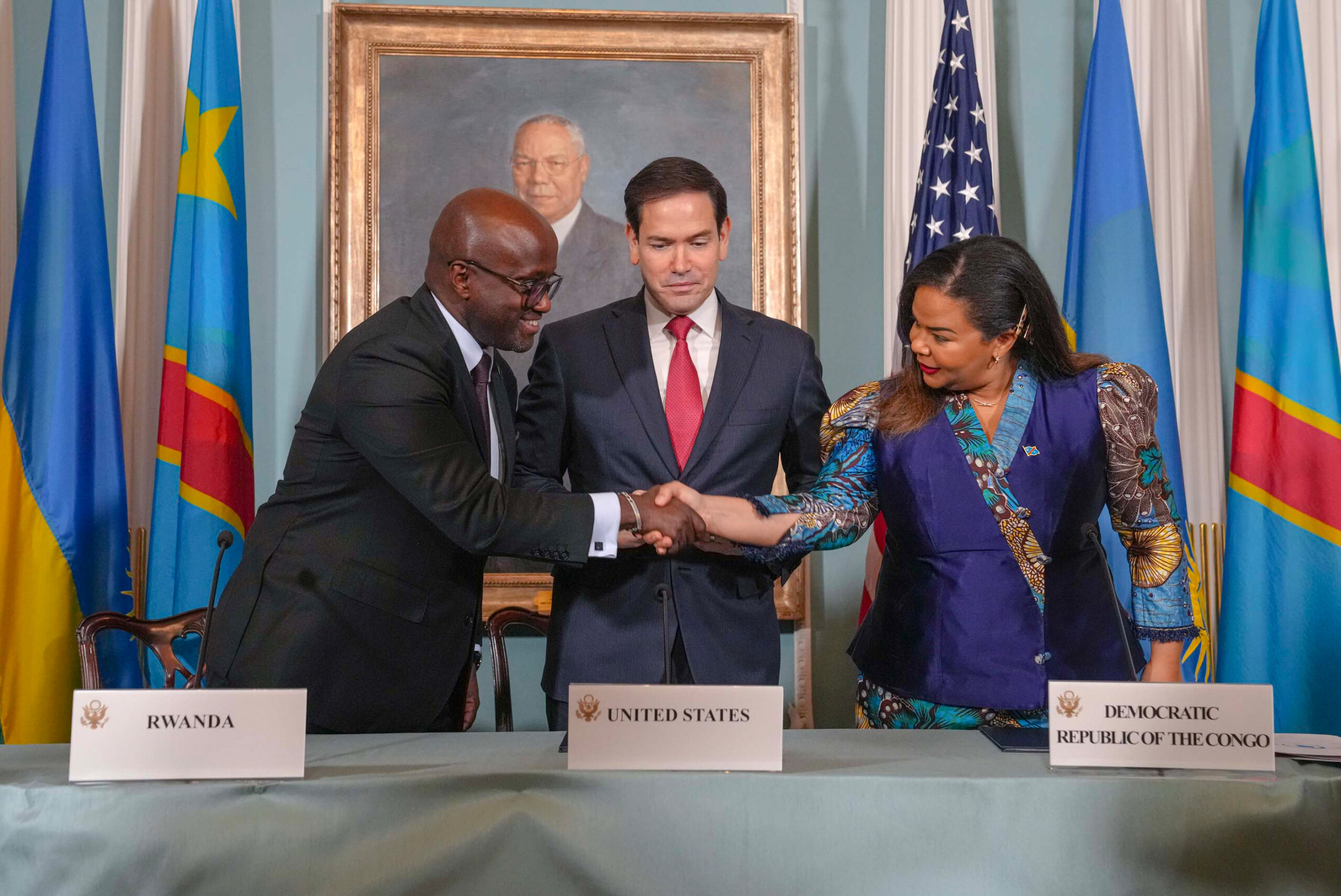Secretary Marco Rubio hosts a Democratic Republic of the Congo-Rwanda Peace Agreement signing ceremony between Democratic Republic of the Congo Foreign Minister Thérèse Kayikwamba Wagner and Rwandan Foreign Minister Olivier Nduhungirehe at the Department of State in Washington, D.C., June 27, 2025. (Official State Department photo by Freddie Everett/Public domain.)
DRC-Rwanda Peace Deal Overshadowed by Minerals
A recent report by the Oakland Institute blames the slow-moving peace process between the Democratic Republic of Congo (DRC) and Rwanda on maneuvering to secure control over Congolese mineral wealth.
The Oakland Institute released a searing critique of negotiations between Democratic Republic of Congo (DRC) and Rwanda on implementing their peace deal as the two nations prepare for the fourth meeting this November. The Institute claims that “longstanding U.S. support for Rwanda made it possible for M23 [a Congolese Rwandan-backed rebel paramilitary group], to seize territory, capture key mining sites, and forced Kinshasa to the negotiation table with hands tied behind its back.”
M23 Expansion and a Flawed Agreement
The peace agreement, initially signed in June, notably excluded key armed groups: the M23 rebels (widely regarded as a Rwandan proxy), the FDLR (a Hutu militia seeking to invade Rwanda), and local self-defense groups known as Wazalendo (patriots).
Since the agreement was signed, the M23 has reportedly expanded its offensive across North and South Kivu Provinces, continuing the unabated extraction of valuable minerals. These resources are primarily trafficked through Rwanda, and to a lesser extent, Uganda, before reaching international markets.
DRC President Felix Tshisekedi maintains that he will not approve a final peace treaty until Rwanda fully withdraws from eastern Congo and ends its support for the M23. While Rwanda demands the disarmament of the FDLR, the UN Group of Experts suggests this is a pretext.
UN Experts: Mineral Control, Not Defense, is Goal
A July report by the UN Group of Experts refuted Rwanda’s claims of an existential threat, stating: “Rwandan Defense Force’s successive military engagements did not primarily aim at neutralizing the FDLR… Instead, RDF reinforcements and decisive military operations aimed at conquering additional territories, while RDF’s continued presence enabled the M23 to consolidate control in eastern DRC, which secured Rwanda’s access to mineral-rich territories and fertile land, decimated FDLR ranks, and guaranteed political influence in the DRC.”
Sources close to the Rwandan government reportedly indicated that Kigali’s primary objective was to control the DRC’s territory and its natural resources.
The Oakland Institute asserts that Rwanda and Uganda, through periods of shifting alliances and hostilities, have turned eastern DRC into a “theater of proxy warfare” driven by economic gains. These actions, the Institute argues, are “deliberate efforts to control mineral-rich regions and assert dominance in Congolese affairs.”
Humanitarian Crisis and U.S. Involvement
The conflict’s toll on the Congolese people has been catastrophic. Three decades of war have resulted in an estimated 6 million deaths (including those from malnutrition and disease), widespread displacement, and the horrific use of sexual violence as a weapon.
The Oakland Institute’s report, “Shafted: The Scramble for Critical Minerals in the DRC,” connects the current instability to a long history of foreign intervention driven by mineral interests, including coltan, diamonds, gold, cassiterite, copper, cobalt, and uranium. The report highlights the historical context of U.S. involvement, referencing the CIA-orchestrated assassination of Patrice Lumumba in 1960 and later support for Mobutu Sese Seku, as evidence of a long-term strategy to control the country’s mineral wealth.
The Oakland Institute concludes that the “U.S.-brokered ‘peace’ deal” is the latest maneuver in this history, aimed at securing resources in the context of the United States’ geopolitical struggle with China for control over critical resources.
“The incorporation of ‘formalized’ mineral supply chains from eastern DRC to Rwanda exposes the pact’s true aim: Securing access to and control over minerals under the guise of diplomacy and ‘regional integration.’… Framed as peacemaking, this is part of United States’ broader geopolitical struggle with China for control over critical resources.”
The Institute warns that far from fostering peace—with over a thousand civilians killed since the deal was signed—this arrangement risks deepening Congo’s subjugation for the benefit of external powers, all while the suffering of the Congolese people continues unabated. For true peace to take hold in the DRC, the basic needs of its people must be prioritized over the value of its mineral resources.

